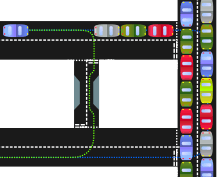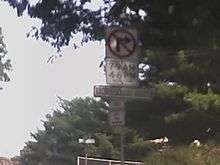Rat running

Rat running or cut-through driving is the practice by motorists of using secondary roads, cemetery roads, or residential side streets instead of the intended main roads in urban or suburban areas.
Background
Rat running is a tactic used to avoid heavy traffic, long delays at traffic signals or other obstacles, even where there are traffic calming measures to discourage its use or laws against taking certain routes. Rat runs are frequently taken by motorists familiar with the local geography. They will often take such shortcuts to avoid busy main roads and intersections.
Rat running is controversial. It is sometimes opposed by residents on the affected streets, as some people regard it as a disturbance of their peace. Sometimes, it affects house prices. Authorities often try to prevent it, but enforcement is difficult. Rat running is sometimes fought by installing traffic calming devices, such as speed humps, traffic circles, and rumble strips, by making some streets one-way, or by blocking off certain intersections. Some places, including Montgomery County, Maryland; Maryland Heights, Missouri; and parts of Minneapolis, Minnesota, have banned turning on certain streets during rush hours to prevent rat running.[1]
Common strategies
Side street usage
Motorists familiar with an area sometimes use side streets or other smaller roads that run parallel in the same direction as the main road. They are generally local people who know these streets and the pros and cons of using them as alternatives to the main road.
Red light avoidance
In some places, motorists avoid stopping at a red light by turning on to a side street or into a parking lot to bypass it.
In some countries, red lights can be avoided by turning right on red (or left in drive-on-the-left countries), making a U-turn, and then turning right (or left) again back on to the street on which the motorist was traveling. This may require less time than waiting for the light to turn green.
Traffic jam avoidance
Some motorists exit and then re-enter a freeway or motorway at the same junction, or use lanes designated for exiting and merging, or cut across unpaved dividers to frontage roads, to pass stationary traffic.
Some large streets are separated from parallel small residential streets only by a small strip where homeowners park their vehicles. These streets can be used to bypass traffic jams.
Prevention and minimization

Many communities combat rat running by installing traffic calming features such as chicanes, speed tables, speed cushions, curb extensions, cobbled sections, hidden law enforcement and various other measures. Other communities install physical barriers that completely block through-traffic along routes prone to rat running. One of the most extensive uses of this strategy is found in Berkeley, California, where dozens of concrete barriers throughout the city block shortcuts, while still allowing cycling.[2] In Northern Virginia, shortcuts are discouraged by the construction of dead end streets, communities with no outlet, and winding roads designed to confuse, making navigation through the neighborhoods more difficult and time-consuming.[1]
Some US cities (such as St. Louis) make extensive use of mid-block barriers across residential streets, such as rows of planters, curbs, or gates, designed to block the passage of vehicles while simultaneously allowing pedestrians through. This serves to deter rat-running while maintaining a sense of continuity for pedestrians, making the streets more pedestrian-friendly.
Since the 2000s, a number of US states, including Georgia and Maryland,[1] some smaller US jurisdictions, and some parts of the United Kingdom have passed or tried to pass laws restricting rat-running in certain communities to maintain peace and privacy for residents.[3][4] Even where signs clearly mark places where rat-running is prohibited, however, enforcement is difficult and prosecutions are rare.
When a major event draws a large volume of traffic, local police sometimes monitor or block secondary roads to prevent motorists from the event crowd from using such streets to avoid the traffic.[5]
See also
| Look up rat run in Wiktionary, the free dictionary. |
- Energy-efficient driving ("Hypermiling")
- Shunpiking
References
- 1 2 3 Weiss, Eric M. (July 26, 2008). "Neighborhoods Use Broad Palette to Deter Traffic-Shortcut Artists". The Washington Post. Retrieved August 24, 2010.
- ↑ City of Berkeley Traffic Calming History
- ↑ MLIS.state.md.us, BILL INFO-2004 Regular Session-SB 508
- ↑ Derbyshire County Council - Barriers to stop rat running motorists
- ↑ "Rat-Run 2003 contest reveals doorstep traffic hell". Transport 2000. August 26, 2003. Archived from the original on November 23, 2006. Retrieved May 15, 2015.